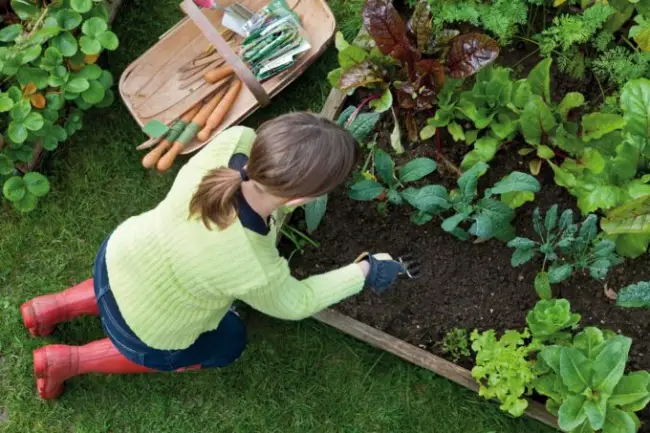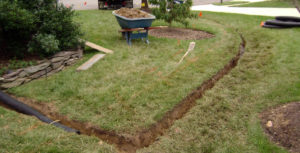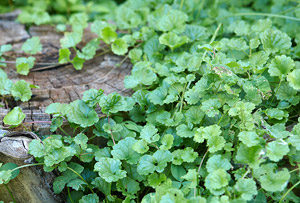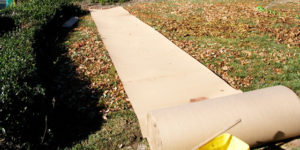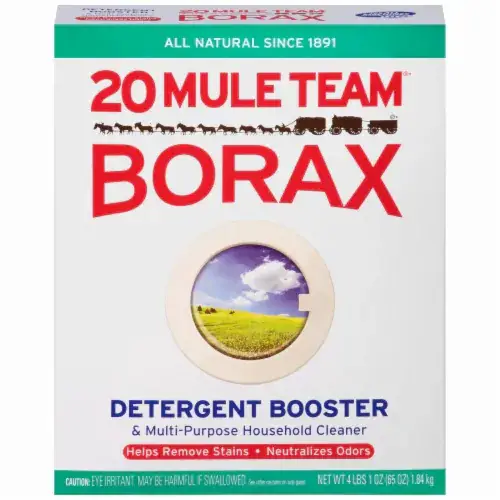Creeping Charlie is a common lawn weed that can be found throughout North America. Its scientific name, Glechoma hederacea, reflects its close resemblance to ivy in terms of its leaf shape and texture. It is an aggressive perennial that spreads through seeds and runners or stolons which root at nodes along the stem and produce new plants.
Creeping Charlie prefers moist soils with the partial sun but thrives in full shade as well. The plant has glossy green foliage with round leaves arranged opposite each other on square stems. Its flowers are small, blue-violet blooms appearing from May to June.
In addition to being unsightly, creeping charlie will quickly take over large areas of your lawn if it’s not controlled effectively. This makes it important for gardeners and homeowners to learn how to get rid of this pesky weed before it takes hold in their yards.
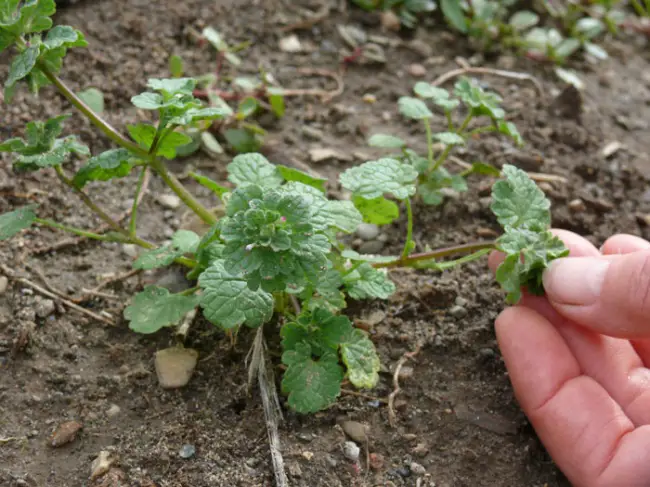
How to Identify and Locate a Creeping Charlie
The best way to identify and locate a Creeping Charlie infestation is by inspecting your lawn on a regular basis. Look for low-growing plants with rounded, scalloped-shaped leaves that are roughly 2 inches long and 1 inch wide. They have distinctive square stems, often forming mats of foliage along the ground’s surface.
These plants will produce small purple blooms from April through June; these will help you identify them more accurately during those months. It’s important to note that while many other annual weeds may look similar, only Creeping Charlie has both roundish leaves and square stems – characteristics that set it apart from other grasses or weeds growing nearby.
With the diligent observation of your landscape and knowledge of what Creeping Charlie looks like, you can begin to take steps toward eliminating it from your property.
It has a node that promotes new growths and forms roots upon contact with soil; this is especially frustrating when attempting to remove these plants, as a new crop of creeping Charlies may emerge if a node is accidentally left behind.
It is only after you have confirmed that you have a creeping charlie problem in your yard that you can take the necessary steps to eradicate them.
How to Get Rid of Creeping Charlie Plants
First, make sure your lawn is in good shape. Creeping Charlies, like any other weed, love a lawn that isn’t cared for properly and becomes unhealthy as a result. Improper lawn maintenance, such as mowing too short or using too much fertilizer, can create ideal conditions for the growth of weeds and other undesirable plants.
Green, thick grass is a sign that your yard is doing well. Those annoying creeping Charlies won’t be able to spread thanks to the abundance of “healthy” grass that will suffocate them. Plants that do well in low-light conditions are another option if you’re concerned about creeping Charlies in areas where regular grass might struggle to grow.
Once you ensure your lawn is healthy and you are employing good lawn caring practices, you can do the following to get rid of creeping charlie plants eventually:
1. Pull the Weeds Out by Hand
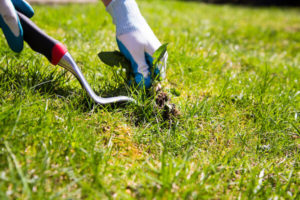
It’s best to pull the weeds by hand instead of using a rake or other tool because of the nodes that can lead to new growth.
Hand-pulling Creeping Charlie is a labor-intensive, yet effective method of controlling the weed’s spread. It is best done with a garden hoe or shovel during dry weather when the soil has dried out and the plant material can be easily removed without too much effort. The roots are shallow so they come up with little resistance.
It is possible to pull the whole plant in one go but it may require repeated pulls over several days if there are large patches of weeds present. Additionally, care should be taken not to disturb nearby desirable plants as this could cause them damage or make them more susceptible to disease.
When pulling Creeping Charlie, any remaining pieces of stem and root should be discarded away from the desired area as these will continue to grow if left behind. To ensure that all parts have been removed, it is useful to check for new growth after a week or two in order to identify any areas that need extra attention.
2. Trim The Leaves And Stems
The first step in getting rid of creeping Charlie is to trim its leaves and stems. This can be done with a pair of garden shears or anvil pruners. Trimming the plant back exposes more sunlight to the ground, which will help other plants compete against it. It is important to cut the stem at the base of each leaf node so that new growth will not sprout from there.
Next, take care to remove all dead or decaying material from around the area where you are performing trimming. Doing this helps keep any disease-causing organisms away from healthy plants nearby. Additionally, make sure to collect all trimmings and dispose of them properly; otherwise, they may reroot themselves elsewhere in your landscape.
After completing the trimming process, check for any areas that have been disturbed by roots or rhizomes–these should be cleared out as well and inspected for regrowth regularly if necessary. By taking these steps now, you can effectively control and manage Creeping Charlie’s spread throughout your property and prevent further infestation problems down the road. Preparing for the next step—soaking the area—will provide additional long-term protection against future invasions of this unwanted weed species.
3. Soak The Area
Creeping Charlie is a common weed found in lawns and gardens. It has a deep root system that makes it difficult to remove without damaging the surrounding grass or plants. The best way to get rid of Creeping Charlie is by soaking the area with water. This will loosen the soil, making it easier for the roots to be pulled out manually.
Soaking also helps to reduce reproduction as some parts of Creeping Charlie are sensitive to prolonged moisture exposure. To maximize effectiveness, soak an infested area twice per week for two weeks in order to thoroughly saturate the ground. If necessary, apply additional treatments such as herbicides but ensure any chemicals used are safe for other plants before application.
It is important to prevent further propagation of this weed by removing all visible portions including leaves or flowers after they have been soaked since even small pieces can still grow into mature plants if left unchecked. Taking these steps will help keep your garden free from Creeping Charlie and allow you to enjoy its beauty without worry.
With proper preparation and care, eliminating this unwanted guest should not be too difficult. Loosening soil around affected areas can make it easier to pull out creeping charlie’s invasive roots and reduce regrowth potentials.
4. Loosen Soil
An effective way of getting rid of Creeping Charlie is to loosen the soil. This can be done by using a spade or shovel and digging around the edges of the infested area, creating small sections that can then be further worked with a rake or hoe. It is important to work only as deep as necessary, being careful not to damage any existing roots in the process. Working too deep could expose new areas for growth and make it more difficult to remove all of the weeds later on.
Loosening up compacted soils will improve drainage, which may reduce future invasions. After working the soil surface one should take time to assess if there are any additional steps needed such as adding organic matter or fertilizer before continuing. Transitioning into removing the roots, it is essential to note that this part of eradicating Creeping Charlie requires extra effort and care in order to ensure complete removal from an area.
5. Remove The Roots
Clearing the area of creeping charlie is an important step for any homeowner. The following four items should be considered when removing this weed:
- Dig around it to loosen the soil and expose its entire root system.
- Cut away as much of the stem and roots can be removed with a garden hoe or shovel.
- Carefully remove each piece of plant material from the ground, making sure not to leave any pieces behind.
- Discard removed plants in a sealed bag far away from your property.
To ensure the complete removal, inspect the area after digging out the weeds. Look for any remaining root fragments or small pieces of foliage left behind in order to eliminate future growth. It may also be helpful to use a post-emergent herbicide if you are unable to manually pull out all of the weeds. This will help reduce potential re-growth and protect other nearby vegetation from further infestation.
6. Inspect The Area
In order to effectively rid a lawn of creeping Charlie, it is essential to inspect the area thoroughly. Depending on the size and shape of the affected area, this should be done either by foot or by using a vehicle such as an ATV or golf cart. It is important to take note of any areas where weeds are particularly thick in order to make sure that all infestations are treated evenly. Additionally, any bare spots should also be noted as these will need to be reseeded after treatments have been applied.
Once the inspection is done, it’s time to figure out which herbicide products will work best. There is a wide range of chemical efficacy, depending on the specific weed species and the extent to which it has spread across the lawn. Complete eradication may require multiple applications. Before applying a pesticide, it’s a good idea to find out what laws apply in your area.
In addition to weed control, regular maintenance measures like mowing, watering, and fertilizing are suggested for optimum turf health and growth. Together, these measures will help prevent further invasions and bring any that have already begun under control.
7. Bring in Some Lighting
Creeping Charlie can thrive in both shade and sunlight, but they favor the damp, dark corners of your yard. It’s possible that removing a tree or an awning that blocks sunlight from reaching your yard will discourage further expansion in that area.
Other Methods to Kill Creeping Charlie
To fight against Creeping Charlie, there are still other methods that you can use. The following are a few efficient and low-cost ways to get rid of Creeping Charlies once and for all.
Use Broadleaf herbicide
This specifically targets a wide range of weeds but is non-harmful towards regular plants. Normally this should be applied in late fall and reapplied in the spring. When the plant is flowering is the time when it is most vulnerable to herbicide treatments, so waiting until this point in the spring could be useful if you’re having difficulties properly eradicating the growths.
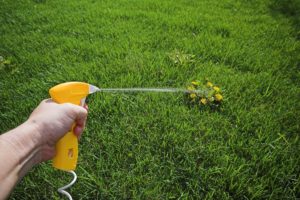
The Cardboard Method
Though creeping Charlies preferentially grow in the shade, completely blocking out the sun can eventually kill the pesky plant. Covering a patch of creeping Charlies with sturdy cardboard weighed down with stones can help smother the plants and prevent sunlight from reaching the plant. It should take about a week for this method to kill the patch, but if you notice a few more plants still alive, cover it up for another week.
Once all are dead, you can remove the dead vines either by hand or with a rake. You won’t have to worry about the nodes regrowing a population of creeping Charlies since the plant and the nodes should be dead.
Borax Treatment
If you’re not against using chemical treatments, then borax may do the trick. Though creeping charlie is resistant to many herbicides, borax has been proven effective, is quite inexpensive, and is extremely accessible. The problem with borax is that if too much is spread, it will kill the growing weeds and any other greenery in the area.
Also, because of the slow speed at which borax degrades, it could stick around in the soil for an extended period of time and prevent anything from growing. Therefore borax isn’t the optimal treatment option but can be used effectively if only little amounts are used.
What Kills Creeping Charlie But Not Grass?
Creeping Charlie is a difficult weed to remove due to its ability to spread quickly and regrow from the smallest of root pieces. In order to get rid of it, an effective herbicide must be applied in order to eliminate any existing plants as well as their rhizomes. Non-selective herbicides that contain glyphosate or glufosinate can be used with caution near desirable plants since they will kill both grass and weeds alike, but there are also other effective solutions available for those looking for something more specific.
Organic options such as horticultural vinegar have been known to work when applied directly on Creeping Charlie’s foliage, though multiple applications may be necessary if the weed has become established over a large area. Additionally, some research suggests combining vinegar with dish soap and water could create an even stronger solution capable of killing larger areas of creeping charlie without harming nearby grasses.
Pelargonic acid is another organic option often favored by landscapers due to its low toxicity levels and effectiveness at selectively targeting broadleaf weeds while leaving surrounding turfgrass unaffected. This substance can come in either liquid form or pre-mixed products designed specifically for eliminating Creeping Charlie infestations. Regardless of which method one decides to use, proper application techniques should always be followed in order to ensure optimal results. The next section will investigate whether vinegar and soap can indeed kill creeping charlie without damaging other vegetation.
Will Vinegar And Soap Kill Creeping Charlie?
Vinegar and soap are two household items that have been used as a method to control the growth of weeds. When used together, they can be effective in killing Creeping Charlie. The combination of vinegar and soap is an inexpensive way to get rid of this troublesome weed without using harmful chemicals or herbicides.
The acidity level of vinegar is key when attempting to kill creeping Charlie. Vinegar should be mixed with water at a ratio of 10:1 for best results; that is, 10 parts water and 1 part vinegar. The mixture should then be sprayed directly onto the leaves of the weed until it starts wilting. Adding liquid dish detergent helps improve effectiveness by penetrating the plant’s protective surface layer and allowing more vinegar to enter its tissue. This mixture can also be poured around the base of plants to prevent further spread of creeping Charlie into other areas.
Any dead foliage needs to be removed from affected areas before new seedlings can form. Careful monitoring over several weeks will help ensure that all traces of creeping Charlie have been eliminated from your garden or lawn area. Removing any remaining roots will also reduce the chances of regrowth in future seasons.
How Does Epsom Salt Get Rid Of Creeping Charlie?
Epsom salt is a popular and effective method of controlling the spread of creeping Charlie. The active ingredient in Epsom salt, magnesium sulfate, works to suppress the growth of this invasive weed by disrupting its ability to absorb certain nutrients from the soil. Additionally, it can help reduce water intake which reduces vigor and helps control weeds without harming grasses or other desirable vegetation.
The application process for using Epsom salt on creeping Charlie is simple; apply an even layer over the entire area where you would like to contain or eliminate the plant. It is important that no bare spots are left uncovered as these will not be affected by the product’s effects. For best results, wait at least two weeks before reapplying, and remember to wear gloves when handling Epsom salt as it may cause skin irritation.
It is also important to note that while Epsom salt does provide effective control against common lawn pests such as Creeping Charlie, it should not be used indiscriminately as doing so could lead to serious environmental damage due to nutrient imbalances. As always, consider consulting with a professional horticulturalist prior to applying any chemical herbicides or fertilizer treatments onto your lawn or garden beds. With proper application and precautions taken, however, homeowners should find success in containing this troublesome weed through the use of Epsom salts.
Final Thoughts
Weeds can potentially destroy a beautiful garden, restricting nutrients from the plants that need them. And though creeping Charlies can be initially difficult to get rid of, by ensuring your lawn is maintained and using some basic gardening principles, you can be sure to say goodbye to this pest.
Even though creeping Charlies are visually appealing, they are terrible for your lawn and should be eliminated. However, if you know when and how to kill these plants, your work will be much simpler.
Read also: Typical lawn care problem

